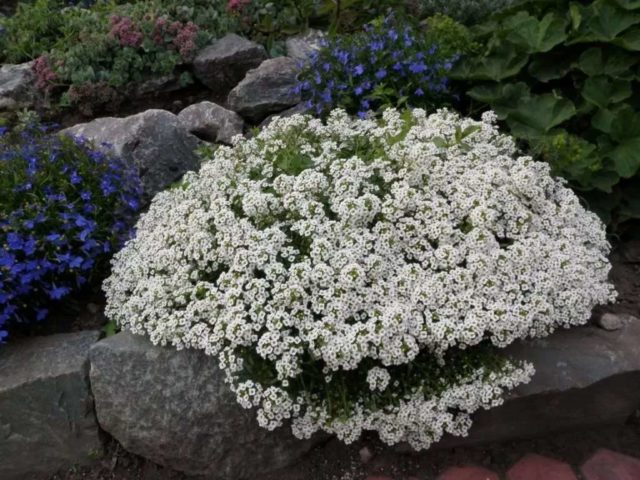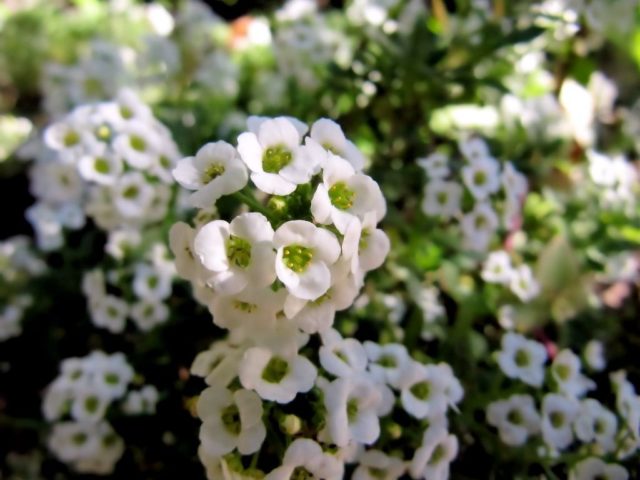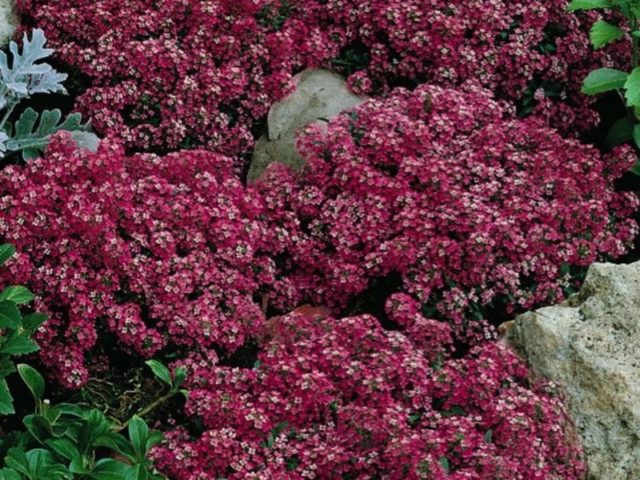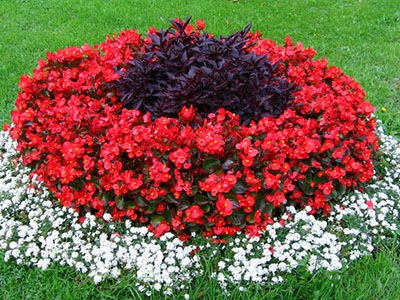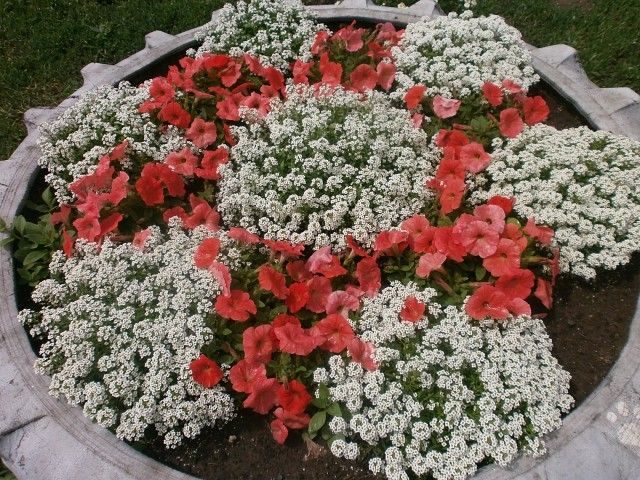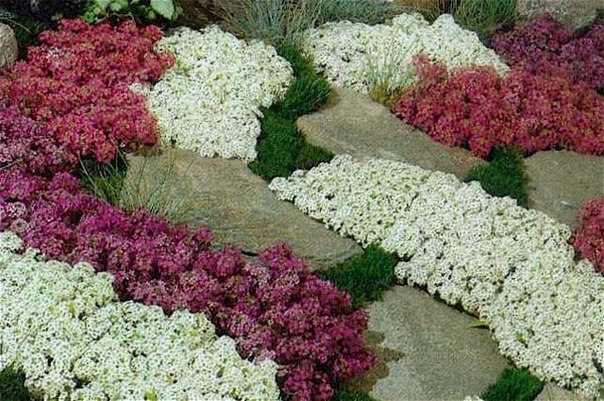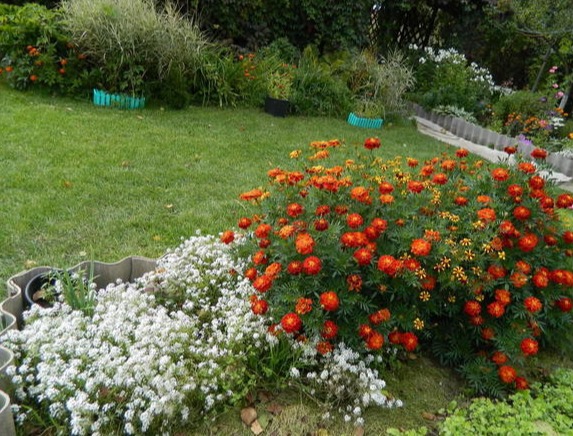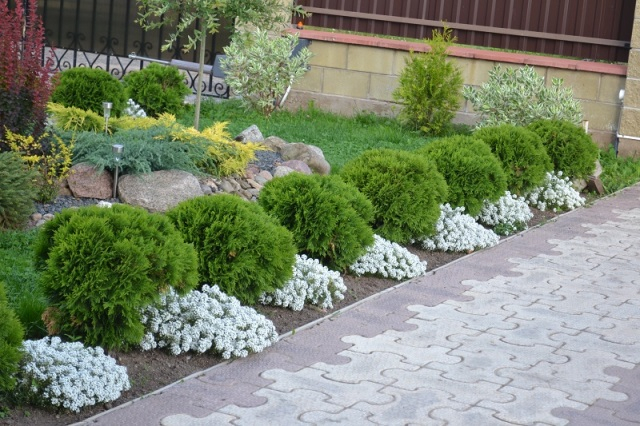Content
Sea alyssum is a beautiful shrub covered with small flowers of white, pale pink, red and other shades. The culture is grown in the central part of Russia and in the South, because it loves light and warmth. Alyssum is unpretentious in leaving, so any summer resident will be able to grow it.
Description of sea alyssum
Alyssum sea (seaside) is a perennial flowering plant, which is a low-growing shrub (20-40 cm). The stems twist and spread along the ground. The shrub is quite compact. Lanceolate small leaves densely cover the shoots.
On each stem, 4-5 peduncles are formed with numerous small flowers collected in a brush. Flowering begins in June and lasts all summer until early September. Coloring is very different (depending on the variety):
- white;
- light blue;
- lilac;
- pale pink and others.
The history of the origin of the marine lobularia is associated with southern Europe (Balkans, Italy, Spain, Portugal). One of the names of this plant is translated as "stone stone". The fact is that alyssum is indeed often found on rocky, depleted soils. Therefore, it is able to grow even with minimal maintenance.
It is also known that in ancient times the word "alyssum" denoted a dangerous disease "rabies". For its treatment, lobularia was often used - therefore, the flower received the corresponding name in Latin.
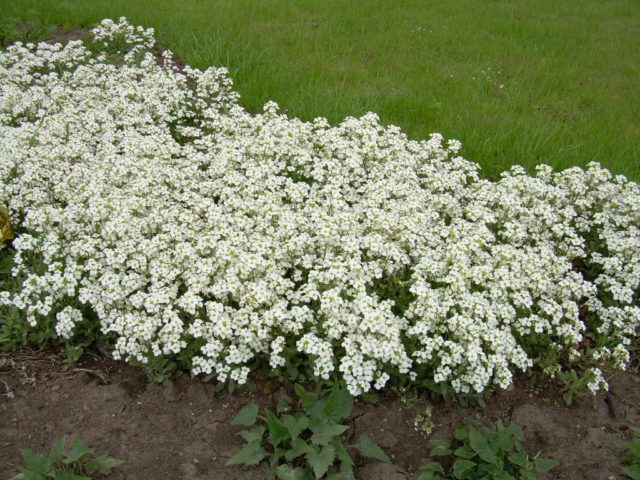
Numerous flowers of alyssum marine almost completely hide the green part of the plant
Varieties of sea alyssum
The sea lobularia alyssum has many species. Among the popular varieties are:
- Alyssum is marine white.
- Alyssum cream.
- Pink.
- Red is a very beautiful seaside lobularia alyssum with bright scarlet flowers.
- Purple.
Application in landscape design
Sea alyssum is an attractive plant. Numerous small flowers are collected in lush inflorescences. The long flowering period guarantees high decorative qualities. Therefore, alissum is used both in single landings and in other variants:
- flower arrangements with contrasting combinations;
- complex flower beds with patterns and rocky surfaces;
- mixborders with other colors;
- paths from sea allisum and conifers;
Breeding features
The main method is seed propagation. They are harvested from dried fruits (capsules) at the end of September. You can first lay a blanket under the alissum bush or sweep the already fallen boxes with a broom. The seeds are stored in natural fabric bags in the refrigerator.
Alyssum marine can be diluted by dividing the bush and cuttings. Cuttings are harvested at the beginning of summer so that they have time to take root before the onset of the winter season. You can divide the bush in mid-September. The resulting cuttings should have 2-3 powerful shoots so that they can successfully take root and give new branches as early as next spring.
Landing and caring for marine alyssum
To grow sea alyssum at home, seeds can be harvested in the fall or purchased at a specialized store. The next season, seedlings are grown from them and after 2 months they are transferred to open ground.Caring for seedlings is simple, so even novice amateurs can engage in crop cultivation.
Timing
Growing seedlings is carried out according to standard rules. Sowing should be started at the end of February or at the beginning of March. Saplings ripen in 60-70 days, and planting in open ground is carried out in the middle or at the end of May (there should be no frost). In the south, seedlings of alyssum marine can be planted at the end of April.
Growing seedlings of sea alyssum
Growing alyssum marine from seeds is quite affordable at home. To do this, you need to purchase a universal soil for seedlings or make it yourself from garden soil and peat (in equal quantities) with a small addition of sand. The mixture is preliminarily kept in a 1% solution of potassium permanganate for 8-10 hours. Then washed with water and dried for several days.

You can pick up any containers for seedlings of sea alyssum
Plastic cups, peat pots or tablets will work, or you can use regular seedling cassettes. It is not necessary to soak them - before sowing, you can only pickle in potassium permanganate. Further sequence of actions:
- They wash (and, if necessary, disinfect the containers), wipe dry and cover the soil.
- Moisten and distribute small seeds over the top layer and lightly crush them with earth.
- Leave in a cool place at a temperature of 10-12 ° C (but not lower).
- A phytolamp is installed and the plants are illuminated for 10-12 hours a day.
- After the first shoots appear (you can expect up to 10 days), a complex mineral fertilizer is added.
- The pick is carried out after the formation of the third leaf.
Transfer to the ground
When planting, it is important to remember that sea alyssum likes well-lit and dry enough places. It is better to place it on a small hill, but not in a low place. If possible, the site should be protected from drafts and strong shade.

In order for the alissum to form a flower carpet, flowers are planted at a distance of 20 cm
Seedlings should be transferred to open ground in mid-May, and in the south at the end of April. Algorithm for the landing of alisum marine:
- It is necessary to clear the weeds and dig up the area.
- Make several small holes at a distance of 25 cm.
- Lay a small drainage layer of small stones, broken brick or expanded clay.
- Root the seedlings and water them.
Also, in the middle or at the end of May, you can plant the seeds of sea alyssum immediately in open ground. The grown seedlings are regularly watered and covered with foil for the first two weeks. Periodically ventilate, and then remove the protective layer. After that, they are seated and grown in a permanent place.
Care features
Alyssum marine does not need special care. It tolerates droughts, short-term cold snaps and grows even on poor soil. However, for lush flowering, several rules must be followed:
- Water so that the soil remains slightly moist. Drying and erosion should not be allowed.
- Fertilizers are applied several times per season: before planting seedlings in open ground, a complex nitrogen composition is required, at the stage of bud formation and flowering - superphosphate and potassium salt (every 2-3 weeks).
- Pruning is done in early spring, before active sap flow begins. At this time, all old branches are removed, as well as shoots that spoil the shape of the bush.
- The soil is mulched to retain moisture and suppress weed growth.
- After each application of top dressing, it is advisable to loosen the soil so that the nutrients are absorbed as much as possible by the roots of the sea alissum.

Even minimal care will ensure abundant flowering of the sea alyssum.
Wintering
Sea alyssum is moderately hardy. Therefore, it is grown in some regions of Central Russia, as well as in the south. Preparing it for winter is not difficult:
- The last top dressing is applied in mid-August.
- In September, water recharge irrigation is carried out.
- Gently bend the branches and fix them to the ground.
- A layer of leaves, spruce branches, straw is thrown on top and covered with agrofibre.
Diseases and pests
Alyssum marine is resistant to diseases and pests. Damage to various viral and fungal diseases is not excluded:
- late blight;
- powdery mildew;
- mosaic leaf disease.
To prevent these infections, it is recommended to spray the seedlings with any fungicide shortly before transferring them to the open field. After the first signs appear (for example, powdery plaque on the leaves, spots and other obvious symptoms), an urgent treatment is carried out with drugs:
- Bordeaux liquid;
- Thanos;
- Cuproxat;
- Ordan;
- Maksim;
- Fitosporin and others.
Of the insect pests, alyssum is often attacked by caterpillars and a cruciferous flea, which is especially dangerous. In this case, folk remedies are used, for example, weak (1-2%) solutions:
- soda;
- vinegar 9%;
- ammonia;
- dry mustard powder and others.
If the bush needs to be saved from a mass invasion, chemical agents will have to be used. Then Aktara, Karbofos, Decis, Karate and others are used. They act in accordance with the instructions, while observing safety precautions.
Conclusion
Sea alissum can become the hallmark of the site. Compact shrubs with lush flowers look very attractive, they can be used to decorate even the most unsightly corners of the garden. Growing alissum is quite simple, as the plant copes well with many diseases and pests.
